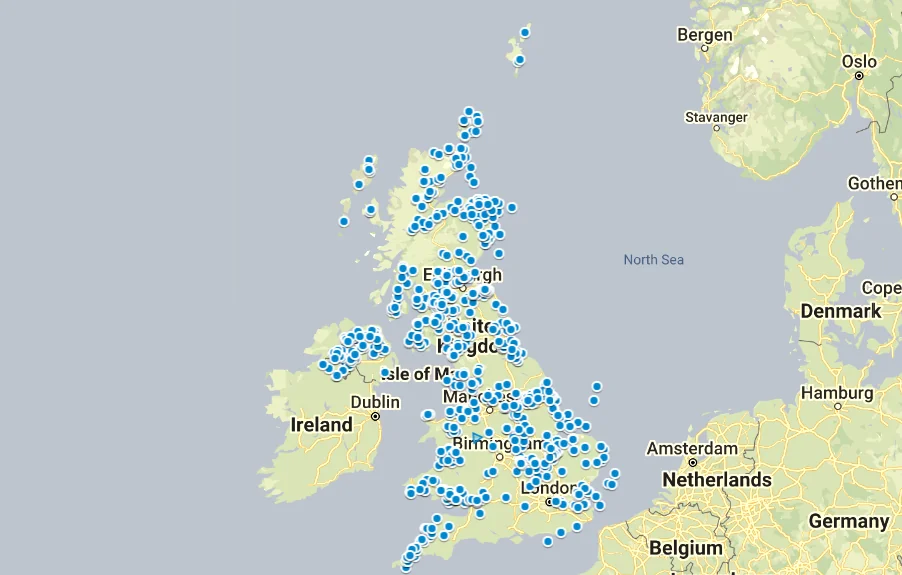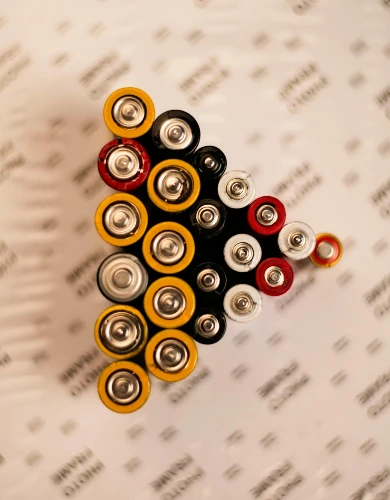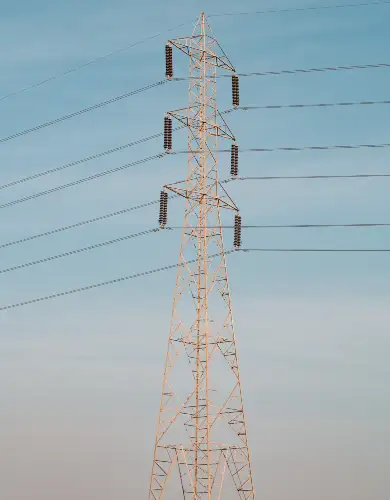Wind farms in the UK
Wind power is now the main power source in the UK and remains the fastest-growing. This is because of decades of relentless investment in wind farms, especially offshore.
This guide examines the most recent official data (April 2024) to provide everything you need to know about the state of wind power in the UK.
Contents
- How do wind farms work in the UK?
- The UK’s wind farm infrastructure: Distribution, types and ownership
- How does wind power affect the UK electricity market?
- The future of UK wind farms
How do wind farms work in the UK?
A wind farm is essentially a wind power station. It comprises an interconnected network of onshore or offshore wind turbines that generate electricity by harnessing wind energy.
All wind farms, regardless of type, generate electricity and distribute it to local and national grid as follows:
- Wind Capture: Wind blowing against turbine blades causes them to rotate. A remote system monitors and adjusts the turbines to ensure they always face the optimal wind direction and operate efficiently.
- Energy Conversion: The rotating blade causes an internal shaft to rotate. Its mechanical energy is converted to electrical energy via a generator. Then, a transformer, either within the turbine or centrally located within the wind farm, will step up the voltage to suit long-distance transmission.
- Distribution: The power output is distributed to homes and businesses through local distribution networks or the national grid. Wind farm operators work closely with grid operators to ensure the wind farm only generates and transmits the required electricity, avoiding waste and maintaining grid stability.
- Payment: Wind farm operators get paid per kWh of electricity generated by domestic and business energy suppliers, who then sell it on and bill consumers. Additionally, brokers can trade it internationally through interconnectors.
Offshore vs onshore wind farms
UK wind farms’ biggest distinction is whether they are onshore or offshore. Here are the key differences in how they work:
| Aspect | Offshore Wind Farms | Onshore Wind Farms |
|---|---|---|
| Location | Several miles offshore, at shallow depths. | Onland in rural or open areas. |
| Power Output | Typically higher, due to a better wind resource and larger turbines. | Typically smaller, due to size and siting restrictions. |
| Wind Speed & Consistency | More consistent and higher wind speeds due to the absence of physical obstructions. | More variable and lower wind speeds due to terrain and obstructions like buildings and trees. |
| Turbine Size | Larger turbines to maximise energy capture from stronger winds. | Usually smaller turbines compared to offshore installations. |
| Installation Complexity | Requires specialised vessels and equipment for transporting and installing turbines at sea. | Easier and less expensive to install, using conventional land-based equipment. |
| Foundation Types | Uses complex foundation types to anchor turbines to the seabed. | Uses simpler foundations like concrete bases or steel piles, driven directly into the ground. |
| Transmission of Electricity | Power from each turbine is transmitted via underwater cables to an offshore substation for voltage step up. Then sent to the mainland through subsea cables. | Electricity is transmitted directly from the turbine or a central onshore substation to the national grid using overhead or underground cables. |
| Maintenance & Access | Maintenance is challenging and costly, requiring boats or helicopters to access the turbines. | Straightforward and less expensive maintenance, with easy road access to turbines. |
| Grid Connection & Control | Offshore farms often require more sophisticated grid integration, with real-time adjustments to account for high power output and variable conditions at sea. | Onshore farms are more directly integrated with the grid, with simpler control systems and easier coordination with grid operators. |
| Economic Factors | Higher initial capital costs due to complex construction and transmission needs, but often higher energy yield. | Lower capital costs with quicker return on investment, though with generally lower energy yields. |
The UK’s wind farm infrastructure
As of April 2024, the UK wind farm infrastructure comprises 9,825 operational wind turbines across 802 wind farms, including onshore and offshore installations in England, Wales, Scotland and Northern Ireland.
Together, these sites have an installed capacity of 29 GW, representing about 27% of the UK’s total. Let’s examine their distribution, types, and operators to get a better idea of how they fit together:
Distribution of UK wind farms
The following map shows all 802 UK wind farms scattered across rural areas and shallow seas of the UK, taking advantage of the UK’s significant wind resource.

Source: Renewable Energy Planning Database April 2024
However, over half of them are small wind farms with capacities of less than 10MW. These are typically composed of no more than five small to medium turbines.
Only about 5% of all UK wind farms exceed a power capacity of 100 MW. The majority of these are offshore and consist of huge turbines often exceeding 100 or even 200 meters in height. Only the largest Scottish onshore wind farms can rival these large capacities.
💡 Did you know? For reference, Drax Biomass Power Station alone can generate up to 3,900 MW of power, showing the sheer scale of turbines needed to compensate for a large power plant.
Onshore vs offshore wind farms in the UK
Here are some key comparative stats between onshore and offshore wind farms based on the official data:
| Category | Offshore Wind | Onshore Wind |
|---|---|---|
| Number of Farms | 47 | 764 |
| Total Installed Capacity | 14,679 MW | 14,100 MW |
| Average Capacity per Farm | 312 MW | 18.5 MW |
| Largest Farm | Hornsea 2 (1,320 MW) | Clyde Wind Farm (350 MW) |
| Smallest Farm | Levenmouth Demonstration Turbine (7 MW) | Lower Rumster (Scotland), Dundrinne Road (NI) (0.2 MW) |
| Total Turbines | 2,791 turbines | 7,034 turbines |
| Average Turbines per Farm | 59 turbines | 18 turbines |
| Most Turbines in a Farm | London Array Phase 1 (175 turbines) | Clyde Wind Farm, Strathclyde (152 turbines) |
| Turbine Capacity Statistics | Average: 5 MW Min: 2 MW Max: 9.5 MW | Average: 2 MW Min: 0.22 MW Max: 4.8 MW |
Source: Renewable Energy Planning Database April 2024
Offshore wind farms generate more power despite having, on average, fewer turbines because of their more abundant wind resources and the lack of turbine size constraints. They generate far more power from fewer but larger turbines.
On the other hand, the 2015 moratorium on onshore wind certainly stunted its growth on the mainland. Despite their many disadvantages, onshore turbines can much more easily connect to and contribute power to the grid.
However, despite progress on a recent policy reversal on onshore wind farm restrictions, huge offshore wind farms are close to being commissioned. These include Dogger Bank (3.6 GW due in 2026) and Hornsea Project Four (2.6 GW due by the late 2020s). The future is offshore.
UK wind farm ownership
The 802 wind farms recorded in April 2024 have many owners/operators. There is a bit of everything, including small private operators, farms, community initiatives and water utility companies vying to cover part of their large energy use. However, the majority of the capacity is generated by a dozen operators. Here are the biggest 16:
| Rank | Company | Installed Capacity | Number of Turbines | Number of Farms (% Offshore / % Onshore) |
|---|---|---|---|---|
| 1 | Orsted | 5359 MW | 922 | 15 (100% / 0%) |
| 2 | SSE | 3515 MW | 993 | 41 (5% / 95%) |
| 3 | Scottish Power | 2823 MW | 1083 | 29 (7% / 93%) |
| 4 | RWE | 1707 MW | 678 | 26 (10% / 90%) |
| 5 | E.ON | 1072 MW | 394 | 16 (35% / 65%) |
| 6 | Innogy | 1129 MW | 221 | 6 (16% / 84%) |
| 7 | Vattenfall | 1047 MW | 314 | 9 (100% / 0%) |
| 8 | Diamond Green Limited, CTG & Ocean Winds | 950 MW | 100 | 1 (100% / 0%) |
| 9 | EDF | 747 MW | 275 | 21 (10% / 90%) |
| 10 | Fred Olsen | 508 MW | 236 | 9 (0% / 100%) |
| 11 | Airtricity | 600 MW | 186 | 5 (20% / 80%) |
| 12 | Greencoat | 632 MW | 285 | 25 (0% / 100%) |
| 13 | Siemens Gamesa | 630 MW | 175 | 1 (100% / 0%) |
| 14 | Statoil | 432 MW | 72 | 2 (100% / 0%) |
| 15 | Equinor | 317 MW | 88 | 1 (100% / 0%) |
| 16 | Octopus | 226 MW | 72 | 7 (0% / 100%) |
Here are a few interesting conclusions from this data:
Orsted’s offshore dominance
Orsted, a global leader in offshore wind, is based in Denmark and dominates the UK market with 5,359 MW from 15 offshore farms. Their focus on offshore wind has made them a key player in the UK’s renewable energy landscape.
SSE’s broad reach
SSE, one of the UK’s largest energy companies, operates the most wind farms (41) in the UK, with a heavy emphasis on onshore wind (95%). Their broad portfolio underscores their commitment to renewable energy across the UK. SSE is also one of Britain’s best business energy suppliers.
Scottish Power’s onshore focus
Scottish Power, a major utility in the UK and a subsidiary of Spain’s Iberdrola focuses heavily on onshore wind, with 93% of its 29 farms on land. This positions them as a major player in the UK’s onshore wind sector. Scottish Power is also a licenced business gas supplier.
Specialised offshore players
Companies like Vattenfall (Sweden), Siemens Gamesa (Germany), and Diamond Green Limited specialize exclusively in offshore wind, reflecting their strategy to harness higher wind speeds and reliability at sea.
Greencoat’s strategy
Greencoat, a UK-based renewable investment firm, focuses on managing many smaller onshore wind farms (25 farms). This approach aligns with their investing strategy in stable, income-generating renewable assets.
How does wind power affect the UK electricity market?
UK wind farms contribute significant amounts of renewable electricity to the British national grid. In 2023, wind power was the largest contributor, with 29.4% of the total power generated in both grids.
Most UK wind farms sell the renewable power they generate using a long-term Power Purchase Agreement.
This is, however, a recent change. Wind power output has increased by over 700% since 2009, bringing unprecedented changes to the grid infrastructure and how electricity must be priced.
These changes will only continue as new wind farm projects develop in the UK.
How did the national grid adapt to wind power?
Unlike fossil fuel plants, wind power is intermittent. The power it can generate depends on wind conditions, so it may not always generate the necessary power to meet demand during peak hours. As a result, the grid has had to make the following adaptations:
- Weather Forecasting: Development of advanced weather forecasting to predict wind power generation and schedule operations.
- Strengthening transmission: Upgrade and expand transmission networks to handle the variability and distribution of wind farms. Upgrades of the transmission network have led to a significant increase in TNUoS charges paid by homes and businesses.
- Flexible power sources: If needed, keep flexible power sources like gas plants and pumped storage hydro with idle capacity. Flexible power sources are incentivised to provide backup power through the BSUoS charge system.
- Demand Flexibility Service: Incentives for homes and businesses to reduce electricity use during certain peak hours as part of the transformation to a flexible energy grid.
- Market mechanisms: Energy trading in both spot and futures markets (within the UK and Europe) helps ensure all wind power is allocated most efficiently.
While these measures have been effective, an influx of tens of GigaWatts of wind power is expected over the next decade. Most experts agree that battery storage will be necessary to store excess wind power during high demand and low winds.
This would allow the UK to unwind some of its gas power stations and keep reducing emissions.
How does wind power affect electricity prices?
There are four main ways in which wind farms interact with both domestic and business electricity tariffs. While subsidies raise the price in the short term, wind power is inherently cheaper because the fuel is free! Here are the details:
- Lowering wholesale prices: Wind farms with low operational costs can reduce wholesale electricity prices by displacing more expensive generation methods, especially during high wind periods.
- Subsidies and levies: UK wind energy is supported by Contracts for Difference (CfD) subsidies, funded through levies on consumer tariffs, ensuring stable income for operators.
- Multi-rate business energy tariffs: Wind farms enable cheaper electricity during high wind generation periods, encouraging consumers to shift their usage accordingly.
- Green Tariffs: Wind farms support green business energy tariffs, allowing consumers to opt for renewable energy at a premium, reflecting the growing demand for sustainability. Find a green electricity tariff for your company with our business electricity comparison service.
In summary, consumers should expect lower business electricity prices over time as renewables harness free energy and their batteries to support them. However, consumers should know that the initial capital investment to make the change will be partially levied on them.
💡Compare business energy prices today to find the most competitive electricity tariffs for your company. Our energy experts are on hand to help you switch business energy suppliers.
The future of UK wind farms
Experts agree that wind power will be the principal energy source in the UK by 2050. In the government’s plans to decarbonise the national grid, wind farms will contribute approximately 50% of the country’s electricity supply by then, with an installed capacity expected to reach around 120 GW.
This ambitious target is part of the UK’s broader strategy to achieve net-zero carbon emissions by mid-century, relying heavily on offshore farms. However, we live in a changing world. Here are some of the things that could affect the UK’s wind future:
- Planning and community opposition: Despite strong support for renewable energy, onshore wind projects often face local opposition due to concerns about visual impact, noise, and property values, as seen with the rejection of the Nant Y Moch wind farm in Wales.
- Supply chain issues: The UK’s reliance on Europe and China for wind turbine components makes it vulnerable to supply chain disruptions, potentially delaying the development of planned wind farms.
- Vulnerability to sabotage: Offshore wind farms are particularly susceptible to sabotage, as their undersea cables are difficult to protect, posing a security risk.
- Alternative wind technologies: Emerging technologies like vertical-axis turbines, Airborne Wind Energy (AWE), vortex bladeless devices, and floating offshore wind turbines could eventually compete with traditional horizontal-axis turbines.
- REGO pricing: Owners of UK wind farms receive Renewable Energy Guarantees of Origin certificates for each MWh of electricity they generate. The viability of future wind projects is impacted by the market value of REGO certificates.

